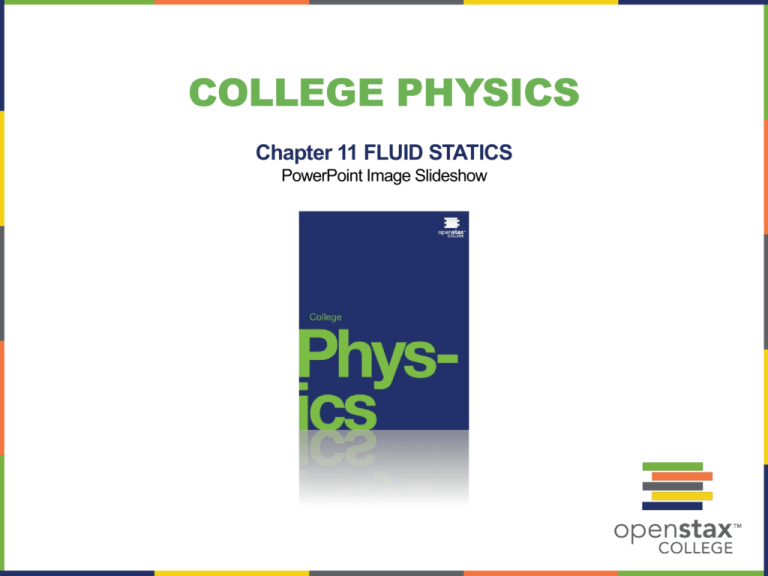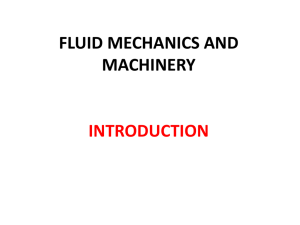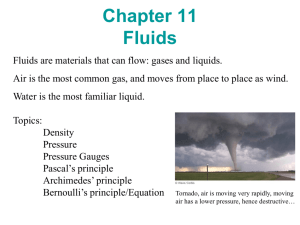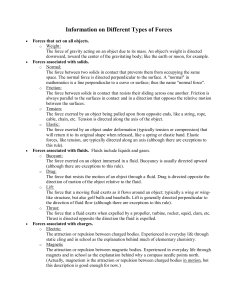
COLLEGE PHYSICS
Chapter 11 FLUID STATICS
PowerPoint Image Slideshow
FIGURE 11.1
The fluid essential to all life has a beauty of its own. It also helps support the weight of
this swimmer. (credit: Terren, Wikimedia Commons)
FIGURE 11.2
(a) Atoms in a solid always have the same neighbors, held near home by forces represented here by springs. These atoms are essentially in
contact with one another. A rock is an example of a solid. This rock retains its shape because of the forces holding its atoms together.
(b) Atoms in a liquid are also in close contact but can slide over one another. Forces between them strongly resist attempts to push them
closer together and also hold them in close contact. Water is an example of a liquid. Water can flow, but it also remains in an open
container because of the forces between its atoms.
(c) Atoms in a gas are separated by distances that are considerably larger than the size of the atoms themselves, and they move about
freely. A gas must be held in a closed container to prevent it from moving out freely.
FIGURE 11.4
A ton of feathers and a ton of bricks have the same mass, but the feathers make a
much bigger pile because they have a much lower density.
FIGURE 11.5
Three Gorges Dam in central China. When completed in 2008, this became the world’s largest
hydroelectric plant, generating power equivalent to that generated by 22 average-sized nuclear
power plants. The concrete dam is 181 m high and 2.3 km across. The reservoir made by this dam
is 660 km long. Over 1 million people were displaced by the creation of the reservoir. (credit: Le
Grand Portage)
FIGURE 11.6
(a) While the person being poked with the finger might be irritated, the force has little
lasting effect.
(b) In contrast, the same force applied to an area the size of the sharp end of a needle
is great enough to break the skin.
FIGURE 11.7
Pressure inside this tire exerts forces perpendicular to all surfaces it contacts. The
arrows give representative directions and magnitudes of the forces exerted at various
points. Note that static fluids do not exert shearing forces.
FIGURE 11.8
Pressure is exerted on all sides of this swimmer, since the water would flow into the space he
occupies if he were not there. The arrows represent the directions and magnitudes of the
forces exerted at various points on the swimmer. Note that the forces are larger underneath,
due to greater depth, giving a net upward or buoyant force that is balanced by the weight of
the swimmer.
FIGURE 11.10
The bottom of this container supports the entire weight of the fluid in it. The vertical
sides cannot exert an upward force on the fluid (since it cannot withstand a shearing
force), and so the bottom must support it all.
FIGURE 11.11
The dam must withstand the force exerted against it by the water it retains. This force is
small compared with the weight of the water behind the dam.
FIGURE 11.12
Atmospheric pressure at sea level averages 1.01×105 Pa (equivalent to 1 atm), since
the column of air over this 1 m2 , extending to the top of the atmosphere, weighs
1.01×105 N .
FIGURE 11.13
A typical hydraulic system with two fluid-filled cylinders, capped with pistons and
connected by a tube called a hydraulic line. A downward force F1 on the left piston
creates a pressure that is transmitted undiminished to all parts of the enclosed fluid.
This results in an upward force F2 on the right piston that is larger than F1 because the
right piston has a larger area.
FIGURE 11.14
Hydraulic brakes use Pascal’s principle. The driver exerts a force of 100 N on the brake
pedal. This force is increased by the simple lever and again by the hydraulic system.
Each of the identical slave cylinders receives the same pressure and, therefore, creates
the same force output F2 . The circular cross-sectional areas of the master and slave
cylinders are represented by A1 and A2 , respectively
FIGURE 11.15
This aneroid gauge utilizes flexible bellows connected to a mechanical indicator to
measure pressure.
FIGURE 11.16
An open-tube manometer has one side open to the atmosphere. (a) Fluid depth must be the same on both
sides, or the pressure each side exerts at the bottom will be unequal and there will be flow from the deeper
side. (b) A positive gauge pressure Pg = hρg transmitted to one side of the manometer can support a
column of fluid of height h . (c) Similarly, atmospheric pressure is greater than a negative gauge pressure
Pg by an amount hρg . The jar’s rigidity prevents atmospheric pressure from being transmitted to the
peanuts.
FIGURE 11.17
In routine blood pressure measurements,
an inflatable cuff is placed on the upper
arm at the same level as the heart. Blood
flow is detected just below the cuff, and
corresponding pressures are transmitted
to a mercury-filled manometer. (credit:
U.S. Army photo by Spc. Micah E.
Clare\4TH BCT)
FIGURE 11.18
A mercury barometer measures
atmospheric pressure. The pressure due
to the mercury’s weight, hρg , equals
atmospheric pressure. The atmosphere
is able to force mercury in the tube to a
height h because the pressure above the
mercury is zero.
FIGURE 11.19
(a) Even objects that sink, like this anchor, are partly supported by water when submerged.
(b) Submarines have adjustable density (ballast tanks) so that they may float or sink as desired. (credit:
Allied Navy)
(c) Helium-filled balloons tug upward on their strings, demonstrating air’s buoyant effect. (credit: Crystl)
FIGURE 11.20
Pressure due to the weight of a fluid
increases with depth since P = hρg . This
pressure and associated upward force on
the bottom of the cylinder are greater
than the downward force on the top of
the cylinder. Their difference is the
buoyant force FB . (Horizontal forces
cancel.)
FIGURE 11.21
(a) An object submerged in a fluid experiences a buoyant force FB . If FB is greater than the weight
of the object, the object will rise. If FB is less than the weight of the object, the object will sink.
(b) If the object is removed, it is replaced by fluid having weight wfl . Since this weight is supported
by surrounding fluid, the buoyant force must equal the weight of the fluid displaced. That is, FB =
wfl ,a statement of Archimedes’ principle.
FIGURE 11.22
An unloaded ship (a) floats higher in the water than a loaded ship (b).
FIGURE 11.23
This hydrometer is floating in a fluid of specific gravity 0.87. The glass hydrometer is
filled with air and weighted with lead at the bottom. It floats highest in the densest fluids
and has been calibrated and labeled so that specific gravity can be read from it directly.
FIGURE 11.24
Subject in a “fat tank,” where he is
weighed while completely submerged as
part of a body density determination. The
subject must completely empty his lungs
and hold a metal weight in order to sink.
Corrections are made for the residual air
in his lungs (measured separately) and
the metal weight. His corrected
submerged weight, his weight in air, and
pinch tests of strategic fatty areas are
used to calculate his percent body fat.
FIGURE 11.25
(a) A coin is weighed in air.
(b) The apparent weight of the coin is determined while it is completely submerged in a
fluid of known density. These two measurements are used to calculate the density
of the coin.
FIGURE 11.27
(a) The soap bubbles in this photograph are caused by cohesive forces among
molecules in liquids. (credit: Steve Ford Elliott)
FIGURE 11.28
Surface tension supporting the weight of an insect and an iron needle, both of which rest on the surface without
penetrating it. They are not floating; rather, they are supported by the surface of the liquid.
(a)
An insect leg dents the water surface. FST is a restoring force (surface tension) parallel to the surface.
(b)
An iron needle similarly dents a water surface until the restoring force (surface tension) grows to equal its
weight.
FIGURE 11.29
Sliding wire device used for measuring
surface tension; the device exerts a force
to reduce the film’s surface area. The
force needed to hold the wire in place is
𝐹 = 𝛾𝐿 = 𝛾(2𝑙), since there are two
liquid surfaces attached to the wire. This
force remains nearly constant as the film
is stretched, until the film approaches its
breaking point.
FIGURE 11.30
With the valve closed, two balloons of different sizes are attached to each end of a tube.
Upon opening the valve, the smaller balloon decreases in size with the air moving to fill the
larger balloon. The pressure in a spherical balloon is inversely proportional to its radius, so
that the smaller balloon has a greater internal pressure than the larger balloon, resulting in
this flow.
FIGURE 11.31
Bronchial tubes in the lungs branch into ever-smaller structures, finally ending in
alveoli. The alveoli act like tiny bubbles. The surface tension of their mucous lining aids
in exhalation and can prevent inhalation if too great.
FIGURE 11.32
Surface tension as a function of surface area. The surface tension for lung surfactant
decreases with decreasing area. This ensures that small alveoli don’t collapse and
large alveoli are not able to over expand.
FIGURE 11.33
In the photograph, water beads on the waxed car paint and flattens on the unwaxed paint.
(a) Water forms beads on the waxed surface because the cohesive forces responsible for surface tension are larger
than the adhesive forces, which tend to flatten the drop.
(b) Water beads on bare paint are flattened considerably because the adhesive forces between water and paint are
strong, overcoming surface tension. The contact angle θ is directly related to the relative strengths of the
cohesive and adhesive forces. The larger θ is, the larger the ratio of cohesive to adhesive forces. (credit: P. P.
Urone)
FIGURE 11.34
(a) Mercury is suppressed in a glass tube because its contact angle is greater than 90º. Surface tension
exerts a downward force as it flattens the mercury, suppressing it in the tube. The dashed line shows
the shape the mercury surface would have without the flattening effect of surface tension.
(b) Water is raised in a glass tube because its contact angle is nearly 0º . Surface tension therefore exerts
an upward force when it flattens the surface to reduce its area.
FIGURE 11.36
(a) Capillary action depends on the radius of a tube. The smaller the tube, the greater
the height reached. The height is negligible for large-radius tubes.
(b) A denser fluid in the same tube rises to a smaller height, all other factors being the
same.
FIGURE 11.37
(a) When the piston is raised, it stretches the liquid slightly, putting it under tension and
creating a negative absolute pressure 𝑃 = −𝐹 / 𝐴 .
(b) The liquid eventually separates, giving an experimental limit to negative pressure in
this liquid.
FIGURE 11.37
Schematic of the circulatory system
showing typical pressures. The two
pumps in the heart increase pressure
and that pressure is reduced as the
blood flows through the body. Long-term
deviations from these pressures have
medical implications discussed in some
detail in the Fluid Dynamics and Its
Biological and Medical Applications.
Only aortal or arterial blood pressure can
be measured noninvasively.
FIGURE 11.38
The intraocular eye pressure can be read with a tonometer. (credit: DevelopAll at the
Wikipedia Project.)
FIGURE 11.39
(a)
During inhalation, muscles expand the chest, and the diaphragm moves downward, reducing pressure inside
the lungs to less than atmospheric (negative gauge pressure). Pressure between the lungs and chest wall is
even lower to overcome the positive pressure created by surface tension in the lungs.
(b)
During gentle exhalation, the muscles simply relax and surface tension in the alveoli creates a positive pressure
inside the lungs, forcing air out. Pressure between the chest wall and lungs remains negative to keep them
attached to the chest wall, but it is less negative than during inhalation.
FIGURE 11.40
FIGURE 11.41
Because the river level is very high, it has started to leak under the levee. Sandbags
are placed around the leak, and the water held by them rises until it is the same level
as the river, at which point the water there stops rising.
FIGURE 11.42
FIGURE 11.43
A water manometer used to measure pressure in the spinal fluid. The height of the fluid
in the manometer is measured relative to the spinal column, and the manometer is
open to the atmosphere. The measured pressure will be considerably greater if the
person sits up.
FIGURE 11.44
(a) When the piston is raised, it stretches the liquid slightly, putting it under tension and
creating a negative absolute pressure 𝑃 = −𝐹 / 𝐴
(b) The liquid eventually separates, giving an experimental limit to negative pressure in
this liquid.
FIGURE 11.45
Hydraulic and mechanical lever systems are used in heavy machinery such as this
back hoe.
This PowerPoint file is copyright 2011-2013, Rice University. All
Rights Reserved.





